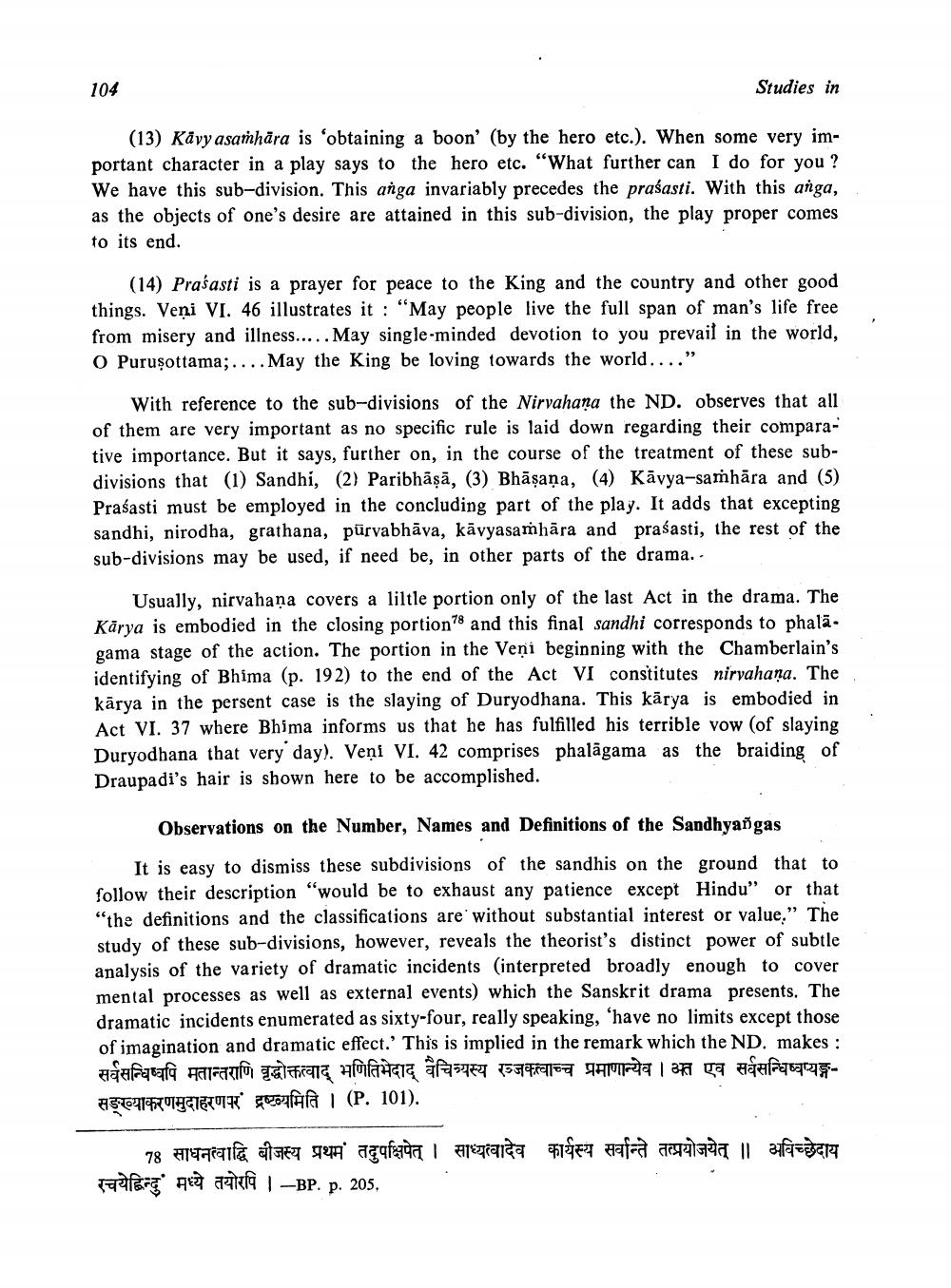________________
104
Studies in
(13) Kavyasamhāra is 'obtaining a boon' (by the hero etc.). When some very important character in a play says to the hero etc. "What further can I do for you? We have this sub-division. This anga invariably precedes the prasasti. With this anga, as the objects of one's desire are attained in this sub-division, the play proper comes to its end.
(14) Prasasti is a prayer for peace to the King and the country and other good things. Veņi VI. 46 illustrates it: "May people live the full span of man's life free from misery and illness..... May single-minded devotion to you prevail in the world, O Purusottama;....May the King be loving towards the world...."
With reference to the sub-divisions of the Nirvahana the ND. observes that all of them are very important as no specific rule is laid down regarding their compara tive importance. But it says, further on, in the course of the treatment of these subdivisions that (1) Sandhi, (2) Paribhāṣā, (3) Bhāṣaṇa, (4) Kävya-samhhära and (5) Prasasti must be employed in the concluding part of the play. It adds that excepting sandhi, nirodha, grathana, pürvabhāva, kävyasamhära and prasasti, the rest of the sub-divisions may be used, if need be, in other parts of the drama...
Usually, nirvahana covers a little portion only of the last Act in the drama. The Karya is embodied in the closing portion" and this final sandhi corresponds to phalagama stage of the action. The portion in the Vent beginning with the Chamberlain's identifying of Bhima (p. 192) to the end of the Act VI constitutes nirvahana. The karya in the persent case is the slaying of Duryodhana. This karya is embodied in Act VI. 37 where Bhima informs us that he has fulfilled his terrible vow (of slaying Duryodhana that very day). Vent VI. 42 comprises phalagama as the braiding of Draupadi's hair is shown here to be accomplished.
Observations on the Number, Names and Definitions of the Sandhyangas
It is easy to dismiss these subdivisions of the sandhis on the ground that to follow their description "would be to exhaust any patience except Hindu" or that "the definitions and the classifications are without substantial interest or value," The study of these sub-divisions, however, reveals the theorist's distinct power of subtle analysis of the variety of dramatic incidents (interpreted broadly enough to cover mental processes as well as external events) which the Sanskrit drama presents. The dramatic incidents enumerated as sixty-four, really speaking, 'have no limits except those of imagination and dramatic effect.' This is implied in the remark which the ND. makes: सर्वसन्धिष्वपि मतान्तराणि वृद्धोक्तत्वाद् भणितिभेदाद् वैचित्र्पस्य रज्जकत्याच प्रमाणान्येव अत एव सर्वसन्धिष्वप्यङ्गसरूपाकरणमुदाहरण द्रष्टव्यमिति । (P. 101).
78 साधनत्वाद्वि बीजस्य प्रथमं तदुपक्षिपेत् साध्यत्वादेव कार्यस्य सर्वान्ते तत्प्रयोजयेत् | अविच्छेदाय रचयेद्विन्दु ं मध्ये तयोरपि । – BP. p. 205,




